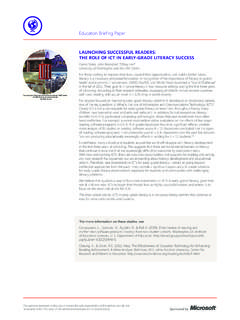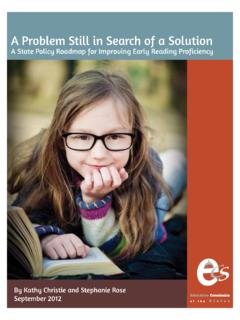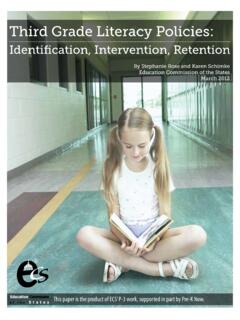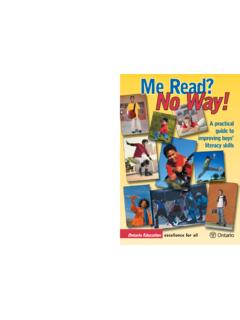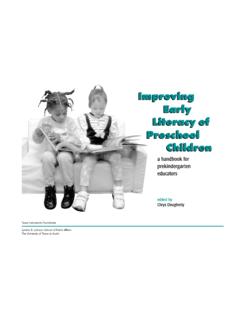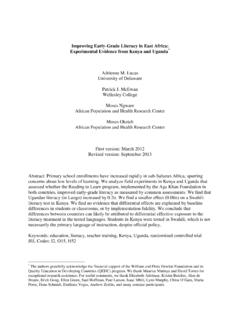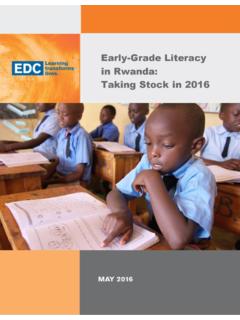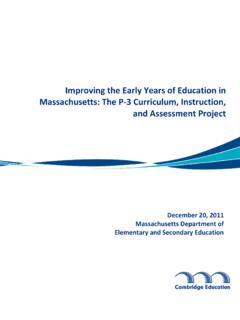Transcription of A Comprehensive Approach to Improve 3 Grade Literacy
1 215 S. Washington Square, Suite 110, Lansing, MI 48933 P: 517-485-3500 March 2015 A Comprehensive Approach to Improve 3rd Grade Literacy As part of his fiscal year 2015-2016 (FY2016) budget proposal, Governor Snyder included a significant focus on improving third Grade reading. Reading proficiently by the end of third Grade can be a make-or-break benchmark in a child s educational development. Up until the end of third Grade , most children are learning to read; and beginning in fourth Grade , they are reading to learn. While only six of every ten Michigan students demonstrated reading proficiency in third Grade in 2013, the statistics were significantly worse for certain groups of students, particularly students of color.
2 To tackle this, the Governor s FY2016 budget recommendations include a new $ million investment ($25 million in general funds) to Improve Literacy and increase third Grade reading proficiency. The Governor acknowledged that his recommendations to address third Grade reading proficiency are a beginning framework from which to continue the dialogue on what improves third Grade reading proficiency and how to best fund those efforts. Below are Michigan s Children s budget recommendations to increase Literacy with a focus on ensuring that young learners of color have the supports they need to be reading proficiently by third Grade .
3 $6 million for Parent Coaching and Support through Home Visiting: Increase the Early Childhood Block Grant by $6 million for a total of $ million to Intermediate School Districts (ISDs) or a consortium of ISDs. The new $6 million investment is targeted for voluntary, evidence-based parent coaching and support services through home visits targeted to at-risk children and their families with goals to Improve school readiness, reduce the number of pupils retained in Grade level, and reduce the number of pupils requiring special education services. These programs have demonstrated outcomes that ensure children are developmentally on-track, that their parents have the tools they need to be their child s first and best teacher, and tackle the achievement gap that emerges well before preschool.
4 $ million for Early On: Appropriate a new $ million state match for Early On, which serves nearly 18,000 families with infants and toddlers birth to age three who have a development delay or disability. While Michigan receives $ million in federal funding through the Individuals with Disabilities Education Act Part C for approximately $639 per child, federal funds are insufficient to fund adequate intervention like speech therapy and specialized instruction. National longitudinal studies demonstrate that 40 percent of infants and toddlers who receive early intervention services will not need special education in prek-12th Grade .
5 215 S. Washington Square, Suite 110, Lansing, MI 48933 P: 517-485-3500 $10 million for Great Start Readiness Program for three-year-olds: Appropriate a new $10 million investment to begin piloting GSRP for the most at-risk three-year-olds to provide a two-year preschool opportunity. Funds should be allocated via competitive process by the Michigan Department of Education Office of Great Start to ISDs that demonstrate how funding will be used to support three-year-olds, including a focus on early Literacy . A portion of this funding should be used for evaluation. GSRP has proven to increase school readiness, Improve math and reading proficiency, reduce Grade retention, and Improve high school graduation rates for children of color.
6 $ million for Early Assessments: As the Governor recommends, invest $ million to field test a kindergarten entry assessment (KEA) with full implementation in the 2016-2017 school year, and $1 million for first and second Grade assessments to determine a student s proficiency levels prior to third Grade . KEAs are an observational assessment tool to identify a child's development so that teachers can provide appropriate instruction for students to succeed in the classroom. $3 million Literacy Coaches: As the Governor recommends, invest $3 million via competitive grants to a consortium of ISDs in the prosperity regions to provide Literacy coaches to support kindergarten through third (k-3rd) Grade teachers.
7 $ million for Multi-Tiered System of Support: As the Governor recommends, provide $ million to administer diagnostic tools to monitor the development of early Literacy and reading skills of k-3rd graders and to support research-based professional development for educators in data interpretation for the purpose of implementing a multi-tiered system of support to Improve reading proficiency. $10 million for Additional Instruction Time in K-3rd Grade : Invest $10 million targeted to before-school, after-school and summer-learning opportunities through Michigan s 21st Century Community Learning Centers (CCLC). Michigan currently receives $38 million in federal 21st CCLC funding to support expanded learning programs in the most challenged communities across the state, but this funds fewer than half of the best programs applying in Michigan.
8 A $10 million investment to fund additional 21st CCLC programs that focus on k-3rd Grade Literacy can reduce the academic achievement gap by improving students performance in reading and math, increasing student participation and engagement, and promoting students development in other areas needed for success in school and life. $5 million for Family Literacy Programs: Invest $5 million to support family Literacy programs via competitive process that concurrently provide classes for adults to Improve their Literacy skills while also providing Literacy rich opportunities for their children through high quality child care and other early childhood education opportunities.
9 A portion of this funding should be used for evaluation. Decades of research tells us that family Literacy is more effective than adults-only or children-only Literacy /reading programs, and young learners will face more struggles to read proficiently if their parents cannot support them through their reading journey. $ million for Child Development and Care (CDC): As the Governor recommends, provide $ million in federal funds to support improvements to the CDC program to increase the exit threshold for child care subsidy eligibility from 121% to 250% of the federal poverty level, to provide 12-months of continuous eligibility for CDC recipients, and to provide tiered reimbursement rates for star-rated quality programs.
10 These quality improvement efforts will ensure more low-income working families can access high quality child care that meets their needs.
